How to Frame a New Door Opening
by: Dale Cox
This page covers framing an existing wall to install a new door. Illustrations and instructions include: cutting into the wall, planning the frame, and installing a new king stud. To save time and make installation easier, you should use a pre-hung door for this project. The packaging will have the dimensions for the rough opening and jamb printed on it to make calculations and measurements simple.
Door Frame Structure

Build a new door frame following the diagram here. The new frame will support the structural load of the wall when the existing supports have been removed.
The parts that come together to form a door frame include: the cripple studs, which transfer the wall load from the top plate to the door header. The header is supported by the jack and king studs along the sides where the load is transferred to the soleplate, which in turn transfers the load to the floor joists and foundation.
Cutting Into the Wall

To start an opening in an interior wall, first remove the plaster or drywall on both sides of the wall. Leave as much of the original drywall in place as possible when doing "demo" work to avoid extensive wall repairs later.
With the wall covering removed, there are two choices for removing the existing framing to make room for a new door. 1-the studs that fall within the new opening can be cut to form the required cripples at the top, or 2-all the framing can be removed and all new pieces installed.
Saving the studs may be the easiest way but both methods have their advantages and disadvantages. Removing them completely will mean an easier cutting job but require additional framing and wall repair. Preserving them can make repairing the wall easier but cutting them off straight can be difficult.
Saving the Framing
To preserve the cripple studs, calculate where to cut them by adding the jamb height (included in the packaging for pre-hung doors), and the header size (calculated below), plus ½inch wiggle room. Remove the plaster or drywall to this point and cut a straight line across the studs you want to save.
Measure from the finished floor and use a square to mark both faces and edges of the wood. Use a handsaw to cut squarely along the lines to ensure a good, flush fit against the header you will be adding. To avoid binding of the saw blade while you're cutting, wedge 2x4's between the floor and top plate to support the wall weight. If you're working on a load-bearing wall, leave the supports in place until you have installed all the new framing.
Installing All New Framing
If you want to remove the studs completely and install new ones, wedge in the supports under the top plate and then cut roughly, mid-way down the wall using a reciprocating saw. Pry the two pieces free from the top and soleplate being careful at the top to avoid breaking a lot of the drywall or plaster off the ceiling.
1# - Plan the New Frame
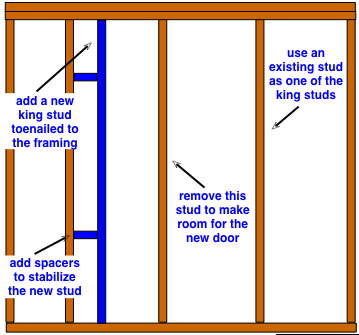
Plan to build your new frame with the jack studs 1 inch wider, and the header ½ inch higher than the size of the new door jamb. This extra space will allow for adjusting the position of the new door jamb for a plumb fit.
Choose an existing studs to serve as the first king stud and then determine if it's necessary to install a new one on the other side, or if one of the studs can be shimmed to do the job. If you can't find two ideal candidates to serve as king studs, which is very likely, you'll have to add a new 2x4 on one side of the new opening.
Locating the New Framing
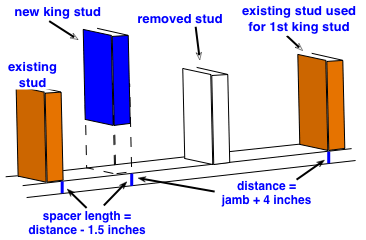
To find the location for the second king stud, add the jamb width, plus 3 inches for jacks, and 1 inch for wiggle room. Measure from the inside of the first king stud and mark this point on the soleplate. Keep this measurement and use it again to cut the header length in the next phase of the framing.
If the next existing wall stud is exactly 1½ inches from the mark, you can just butt a new 2x4 against it to act as the second king stud but most likely things won't be that simple. If the stud is several inches or more from the mark you can add spacers to build out the new 2x4. To cut the spacers, measure to the soleplate mark and subtract 1½ inches (thickness of new 2x4) from this total. Cut 2 or 3 pieces of 2x4 to this length and nail them between the new 2x4 and the existing one.
Shimming a Door Frame
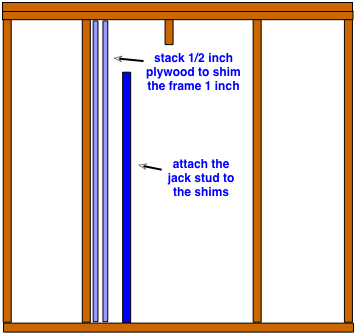
If the stud you want to use is less than 1½ from the mark on the soleplate, you can shim it with boards of the appropriate thickness to build it out. For instance, to build out by one inch, stack 2 pieces of 1/2 plywood and then nail the new jack stud to these plywood shims.
If the distance is a little more than 1½ inches, stack a new 2x4 with the existing one and wedge thin plywood spacers or shim between them to build out to the proper position. The final location can vary slightly but try to get within 1/8 inch of the mark for the best results.
#2 - Install the New King Stud

Measure from the wall top plate to the soleplate and cut a new 2x4 to this length, then install it using two-3 inch deck screws on each end. Drive the screws at an angle to "toenail" it to the plates. You can drill pilot holes first to make driving these screws smoother, and improve control. This also makes it easier to reposition in case of error in placement.
If you need to use spacers to support the new 2x4, install them first before putting the stud in place. Start one screw at the top and bottom of the new stud and then set it in place so it rests squarely against the spacers. Hold the 2x4 in place and drive a screw at each spacers to support it temporarily.
Next, make sure the new stud is aligned with the mark on the soleplate and drive the bottom screw home. Make sure it's plumb using a level held against the side, and then drive the top screw into the top plate. Finally, drive a second screw at the top and bottom, and at each spacer to finish the installation.
#3 - Build the Header

The size of the header will vary depending on the size of the new window or door opening. For example, with openings up to 3 feet wide, 2x4's may be used to build the header; for openings up to 5 feet, 2x6's should be used; over 5 feet, use 2x8's.
With the proper size lumber in hand, use the measurement taken above or add the width of the jamb, plus 3 inches for jack studs and 1 inch for wiggle room. Cut the lumber for the header to this length. Nail the pieces together with a piece of ½in plywood of the same size placed between them to create a header the same thickness as the 2x4 wall framing.
Note: The stated size of lumber is not the actual size, 2x4's are actually 1½in. thick and 3½in. wide. The header sizes here assume lumber of this smaller size in the existing wall. Older houses will have larger framing members, up to the actual 2 by 4 inches. Always measure your framing to be sure.
#4 - Install the Header and Jack Studs
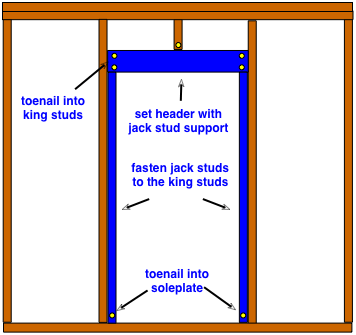
Measure from the top of the header to the bottom of the top plate, and cut the cripple studs to this length. Install one new one for every 3 feet or less of opening.
Add the height of the new jamb plus ½inch and cut two new jack studs to this length. Slide the assembled header into place butted against the cripples, and wedge the jacks under it for temporary support. Square all the new framing members, and fasten the jacks to the king studs using 3 inch screws, driven at about 12 inch intervals.
Drive screws, toenailed at an angle, through the cripples and into the top of the header. Also, toenail through the face of the header and into the kings on both sides of the wall. Finally, toenail through the edge of the jacks and into the soleplate. Make sure none of the screw heads are left protruding so they don't disrupt the installation of new wall material and door casings.
#5 - Cut the Soleplate

After the framing has been installed, cut the soleplate to accept the new door. Use a handsaw to cut through the 2x4 plate right next to the jack studs. Protect floors from the saw blade with a scrap piece of plywood or a similar, thin material. Cut the plate, stopping about 1|8in. from the floor, and use a chisel and hammer to finish the job.
Finish with a Chisel
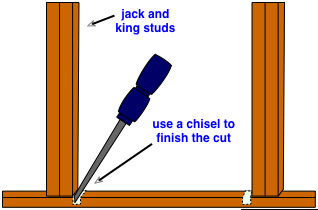
Make a second cut with the saw, about half an inch or more from the studs. Remove the waste to form a channel large enough to use the chisel to cut through the remainder of the soleplate. Pry the loose section of soleplate free from the floor and discard it. With the soleplate removed, the opening is ready for the new pre-hung door.
After the door has been installed, finish the flooring by filling any holes where the soleplate was with wood putty, and refinish the floor to match the rest. If the floor is too rough to refinish, use a threshold saddle to cover it.
In some houses, the interior walls may have been installed before the finished flooring. If this is the case, there will be a gap in the flooring where the soleplate was attached to the sub-floor. Remove the soleplate as described above and fill the gap in the flooring using a piece of wood the same thickness of the finished floor, usually ¾in for solid wood floors. Cover this rough patch with a saddle molding.
 Building a Window Frame
Building a Window Frame Repairing Drywall Damage
Repairing Drywall Damage